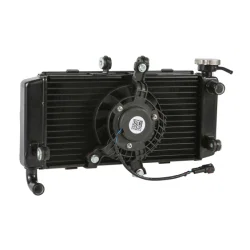Two main types of motorcycle cooling systems
2024-01-02
Motorcycle cooling systems are designed to manage the engine's operating temperature by dissipating excess heat generated during combustion. Proper cooling is crucial for preventing overheating, which can lead to engine damage. There are two main types of motorcycle cooling systems:
1. Air-Cooled Systems:
- How it works: In air-cooled systems, the engine relies on the natural flow of air over fins or cooling fins attached to the engine. These fins increase the surface area, allowing heat to dissipate into the surrounding air.
- Advantages: Air-cooled systems are generally simpler, lighter, and require less maintenance compared to liquid-cooled systems. They are often found on smaller or more classic-style motorcycles.
- Disadvantages: They may be less efficient, especially in extreme temperatures or heavy traffic, where airflow is limited.
2. Liquid-Cooled Systems:
- How it works: Liquid-cooled systems use a coolant (usually a mixture of water and antifreeze) to absorb heat from the engine. The heated coolant is then pumped through a radiator, where it releases heat into the air. A thermostat regulates the coolant flow to maintain an optimal operating temperature.
- Advantages: Liquid cooling is more efficient in maintaining a consistent temperature, even in varied riding conditions. It allows for tighter control over engine temperatures, which can be important for performance and emissions.
- Disadvantages: Liquid-cooled systems tend to be more complex, heavier, and may require more maintenance compared to air-cooled systems.
Key components of a liquid-cooled motorcycle cooling system include:
- Radiator: A heat exchanger that dissipates heat from the coolant into the surrounding air.
- Coolant Pump: Circulates the coolant through the engine and radiator.
- Thermostat: Regulates the flow of coolant to maintain the desired operating temperature.
- Coolant Reservoir: Stores excess coolant and allows for expansion and contraction as the engine heats up and cools down.
Regular maintenance of the cooling system is essential to ensure its proper functioning. This includes checking coolant levels, inspecting hoses and connections for leaks, and cleaning the radiator fins. Additionally, following the manufacturer's recommended maintenance schedule is crucial for keeping the motorcycle's cooling system in good condition.



